Enhancing Nursing Practice: Clinical Governance in Pressure Ulcer Care
VerifiedAdded on 2023/04/23
|8
|2822
|113
Essay
AI Summary
This essay discusses the importance of clinical governance in nursing practice, using a case study of a patient who developed pressure ulcers due to inadequate care. It highlights the failure of a novice nurse to implement proper risk assessment and evidence-based interventions, emphasizing the significance of risk management, education, training, and continuous professional development in preventing and managing pressure ulcers. The essay underscores the role of clinical governance in ensuring high-quality care, patient safety, and satisfaction by promoting adherence to NHS policies, utilizing tools like the Waterlow scale, and fostering patient involvement. It also covers evidence-based treatments for pressure ulcers, such as regular repositioning, specialized mattresses, appropriate dressings, and nutritional support, concluding that clinical governance is essential for nurses to provide optimal care and improve patient outcomes.
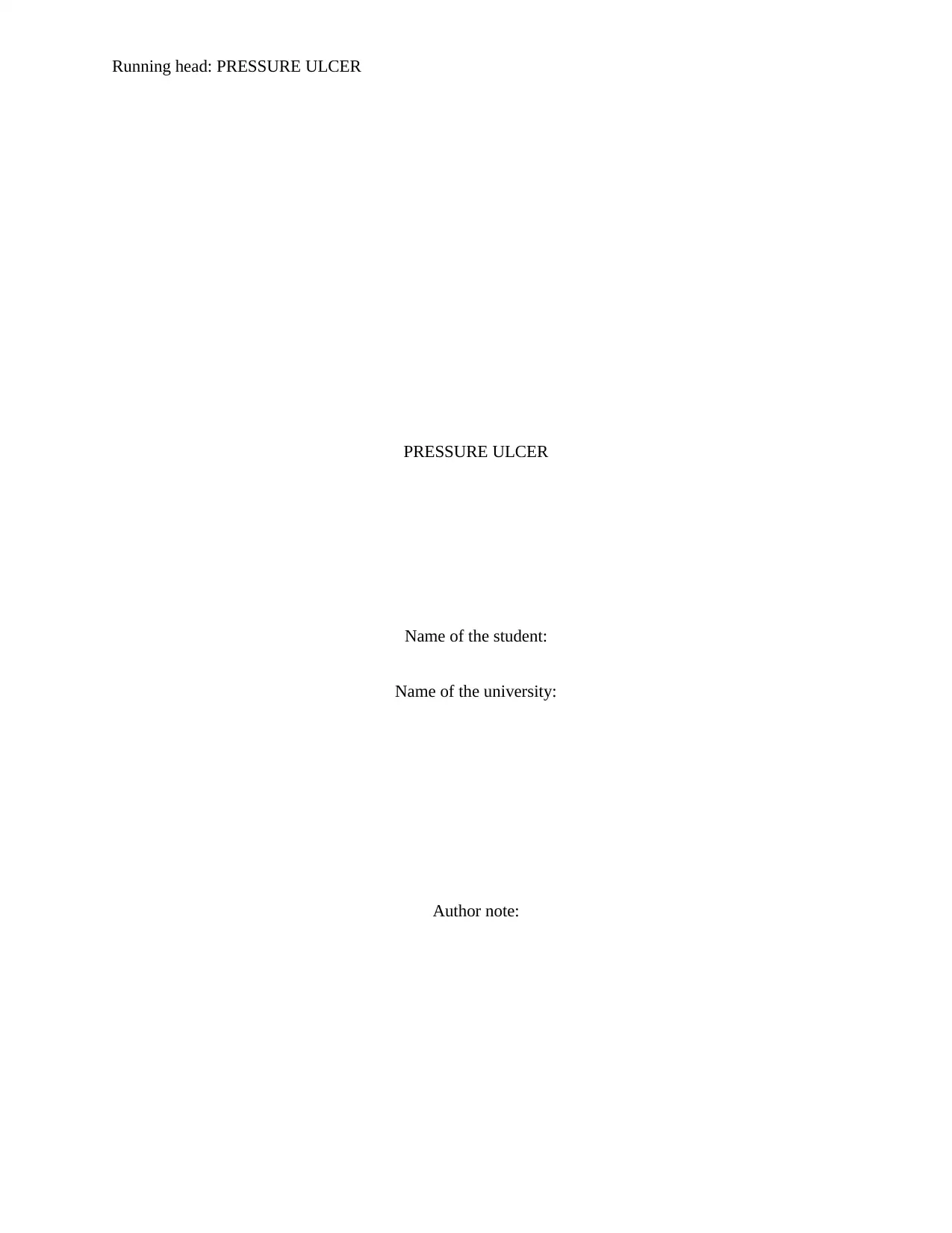
Running head: PRESSURE ULCER
PRESSURE ULCER
Name of the student:
Name of the university:
Author note:
PRESSURE ULCER
Name of the student:
Name of the university:
Author note:
Paraphrase This Document
Need a fresh take? Get an instant paraphrase of this document with our AI Paraphraser
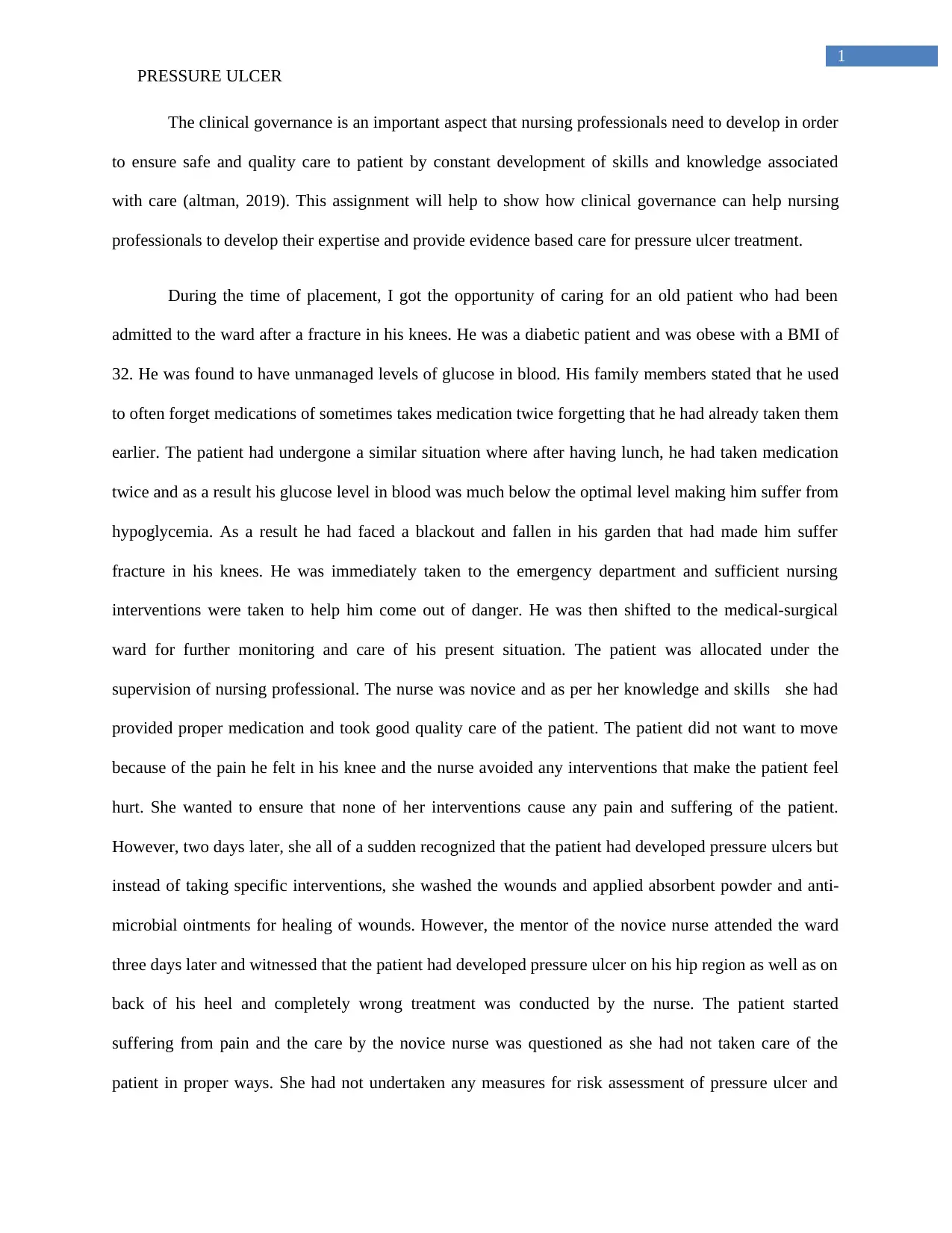
1
PRESSURE ULCER
The clinical governance is an important aspect that nursing professionals need to develop in order
to ensure safe and quality care to patient by constant development of skills and knowledge associated
with care (altman, 2019). This assignment will help to show how clinical governance can help nursing
professionals to develop their expertise and provide evidence based care for pressure ulcer treatment.
During the time of placement, I got the opportunity of caring for an old patient who had been
admitted to the ward after a fracture in his knees. He was a diabetic patient and was obese with a BMI of
32. He was found to have unmanaged levels of glucose in blood. His family members stated that he used
to often forget medications of sometimes takes medication twice forgetting that he had already taken them
earlier. The patient had undergone a similar situation where after having lunch, he had taken medication
twice and as a result his glucose level in blood was much below the optimal level making him suffer from
hypoglycemia. As a result he had faced a blackout and fallen in his garden that had made him suffer
fracture in his knees. He was immediately taken to the emergency department and sufficient nursing
interventions were taken to help him come out of danger. He was then shifted to the medical-surgical
ward for further monitoring and care of his present situation. The patient was allocated under the
supervision of nursing professional. The nurse was novice and as per her knowledge and skills she had
provided proper medication and took good quality care of the patient. The patient did not want to move
because of the pain he felt in his knee and the nurse avoided any interventions that make the patient feel
hurt. She wanted to ensure that none of her interventions cause any pain and suffering of the patient.
However, two days later, she all of a sudden recognized that the patient had developed pressure ulcers but
instead of taking specific interventions, she washed the wounds and applied absorbent powder and anti-
microbial ointments for healing of wounds. However, the mentor of the novice nurse attended the ward
three days later and witnessed that the patient had developed pressure ulcer on his hip region as well as on
back of his heel and completely wrong treatment was conducted by the nurse. The patient started
suffering from pain and the care by the novice nurse was questioned as she had not taken care of the
patient in proper ways. She had not undertaken any measures for risk assessment of pressure ulcer and
PRESSURE ULCER
The clinical governance is an important aspect that nursing professionals need to develop in order
to ensure safe and quality care to patient by constant development of skills and knowledge associated
with care (altman, 2019). This assignment will help to show how clinical governance can help nursing
professionals to develop their expertise and provide evidence based care for pressure ulcer treatment.
During the time of placement, I got the opportunity of caring for an old patient who had been
admitted to the ward after a fracture in his knees. He was a diabetic patient and was obese with a BMI of
32. He was found to have unmanaged levels of glucose in blood. His family members stated that he used
to often forget medications of sometimes takes medication twice forgetting that he had already taken them
earlier. The patient had undergone a similar situation where after having lunch, he had taken medication
twice and as a result his glucose level in blood was much below the optimal level making him suffer from
hypoglycemia. As a result he had faced a blackout and fallen in his garden that had made him suffer
fracture in his knees. He was immediately taken to the emergency department and sufficient nursing
interventions were taken to help him come out of danger. He was then shifted to the medical-surgical
ward for further monitoring and care of his present situation. The patient was allocated under the
supervision of nursing professional. The nurse was novice and as per her knowledge and skills she had
provided proper medication and took good quality care of the patient. The patient did not want to move
because of the pain he felt in his knee and the nurse avoided any interventions that make the patient feel
hurt. She wanted to ensure that none of her interventions cause any pain and suffering of the patient.
However, two days later, she all of a sudden recognized that the patient had developed pressure ulcers but
instead of taking specific interventions, she washed the wounds and applied absorbent powder and anti-
microbial ointments for healing of wounds. However, the mentor of the novice nurse attended the ward
three days later and witnessed that the patient had developed pressure ulcer on his hip region as well as on
back of his heel and completely wrong treatment was conducted by the nurse. The patient started
suffering from pain and the care by the novice nurse was questioned as she had not taken care of the
patient in proper ways. She had not undertaken any measures for risk assessment of pressure ulcer and
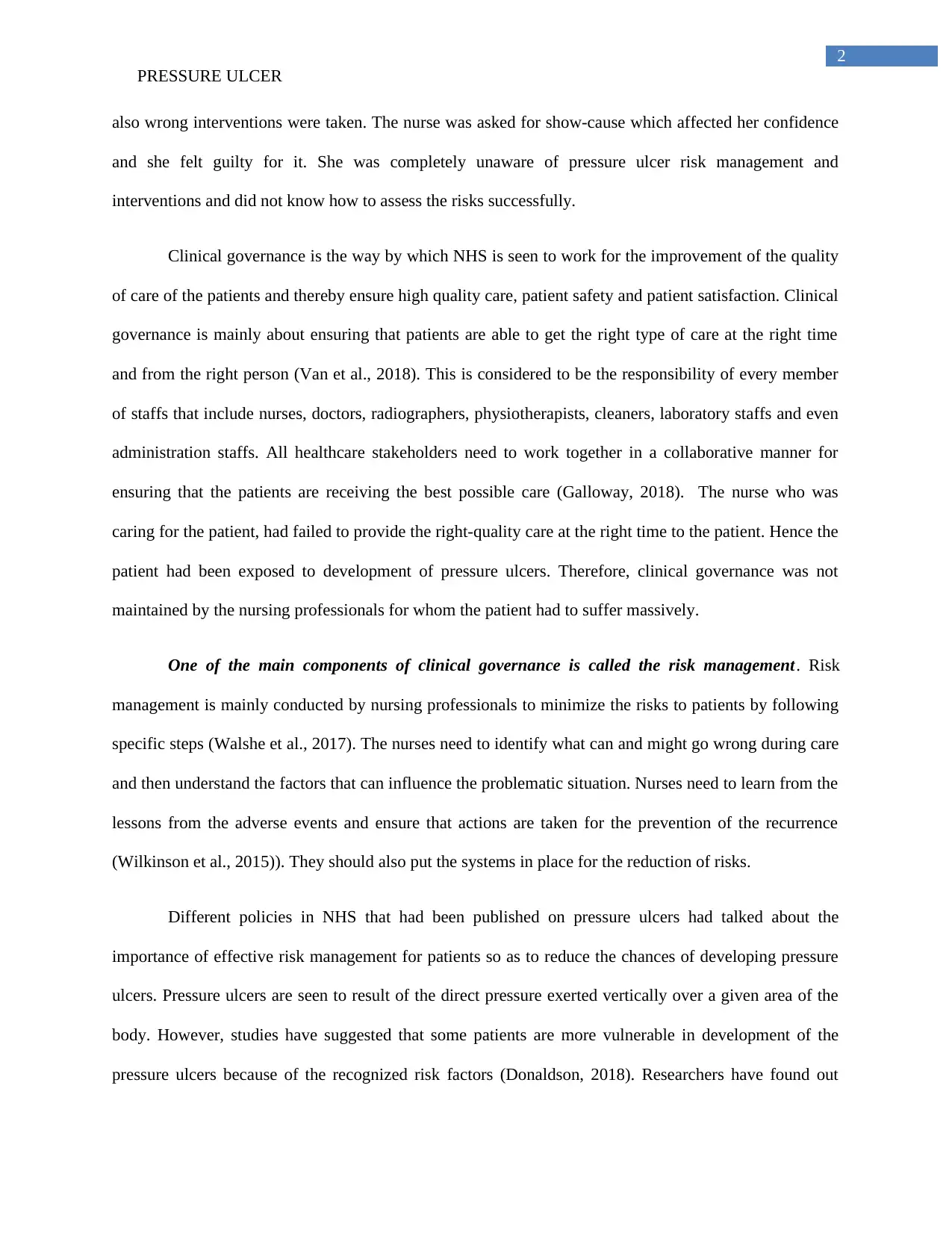
2
PRESSURE ULCER
also wrong interventions were taken. The nurse was asked for show-cause which affected her confidence
and she felt guilty for it. She was completely unaware of pressure ulcer risk management and
interventions and did not know how to assess the risks successfully.
Clinical governance is the way by which NHS is seen to work for the improvement of the quality
of care of the patients and thereby ensure high quality care, patient safety and patient satisfaction. Clinical
governance is mainly about ensuring that patients are able to get the right type of care at the right time
and from the right person (Van et al., 2018). This is considered to be the responsibility of every member
of staffs that include nurses, doctors, radiographers, physiotherapists, cleaners, laboratory staffs and even
administration staffs. All healthcare stakeholders need to work together in a collaborative manner for
ensuring that the patients are receiving the best possible care (Galloway, 2018). The nurse who was
caring for the patient, had failed to provide the right-quality care at the right time to the patient. Hence the
patient had been exposed to development of pressure ulcers. Therefore, clinical governance was not
maintained by the nursing professionals for whom the patient had to suffer massively.
One of the main components of clinical governance is called the risk management. Risk
management is mainly conducted by nursing professionals to minimize the risks to patients by following
specific steps (Walshe et al., 2017). The nurses need to identify what can and might go wrong during care
and then understand the factors that can influence the problematic situation. Nurses need to learn from the
lessons from the adverse events and ensure that actions are taken for the prevention of the recurrence
(Wilkinson et al., 2015)). They should also put the systems in place for the reduction of risks.
Different policies in NHS that had been published on pressure ulcers had talked about the
importance of effective risk management for patients so as to reduce the chances of developing pressure
ulcers. Pressure ulcers are seen to result of the direct pressure exerted vertically over a given area of the
body. However, studies have suggested that some patients are more vulnerable in development of the
pressure ulcers because of the recognized risk factors (Donaldson, 2018). Researchers have found out
PRESSURE ULCER
also wrong interventions were taken. The nurse was asked for show-cause which affected her confidence
and she felt guilty for it. She was completely unaware of pressure ulcer risk management and
interventions and did not know how to assess the risks successfully.
Clinical governance is the way by which NHS is seen to work for the improvement of the quality
of care of the patients and thereby ensure high quality care, patient safety and patient satisfaction. Clinical
governance is mainly about ensuring that patients are able to get the right type of care at the right time
and from the right person (Van et al., 2018). This is considered to be the responsibility of every member
of staffs that include nurses, doctors, radiographers, physiotherapists, cleaners, laboratory staffs and even
administration staffs. All healthcare stakeholders need to work together in a collaborative manner for
ensuring that the patients are receiving the best possible care (Galloway, 2018). The nurse who was
caring for the patient, had failed to provide the right-quality care at the right time to the patient. Hence the
patient had been exposed to development of pressure ulcers. Therefore, clinical governance was not
maintained by the nursing professionals for whom the patient had to suffer massively.
One of the main components of clinical governance is called the risk management. Risk
management is mainly conducted by nursing professionals to minimize the risks to patients by following
specific steps (Walshe et al., 2017). The nurses need to identify what can and might go wrong during care
and then understand the factors that can influence the problematic situation. Nurses need to learn from the
lessons from the adverse events and ensure that actions are taken for the prevention of the recurrence
(Wilkinson et al., 2015)). They should also put the systems in place for the reduction of risks.
Different policies in NHS that had been published on pressure ulcers had talked about the
importance of effective risk management for patients so as to reduce the chances of developing pressure
ulcers. Pressure ulcers are seen to result of the direct pressure exerted vertically over a given area of the
body. However, studies have suggested that some patients are more vulnerable in development of the
pressure ulcers because of the recognized risk factors (Donaldson, 2018). Researchers have found out
⊘ This is a preview!⊘
Do you want full access?
Subscribe today to unlock all pages.

Trusted by 1+ million students worldwide
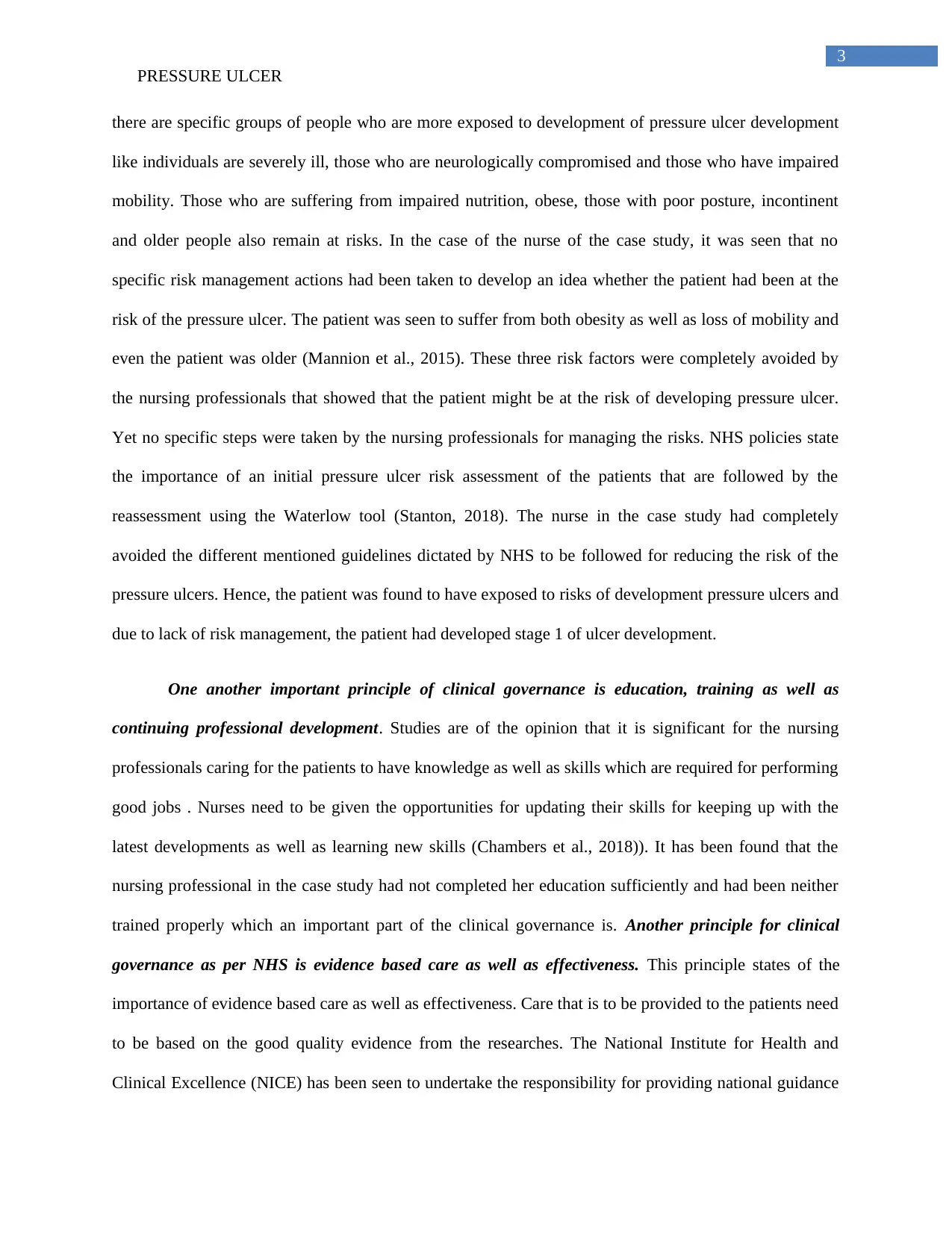
3
PRESSURE ULCER
there are specific groups of people who are more exposed to development of pressure ulcer development
like individuals are severely ill, those who are neurologically compromised and those who have impaired
mobility. Those who are suffering from impaired nutrition, obese, those with poor posture, incontinent
and older people also remain at risks. In the case of the nurse of the case study, it was seen that no
specific risk management actions had been taken to develop an idea whether the patient had been at the
risk of the pressure ulcer. The patient was seen to suffer from both obesity as well as loss of mobility and
even the patient was older (Mannion et al., 2015). These three risk factors were completely avoided by
the nursing professionals that showed that the patient might be at the risk of developing pressure ulcer.
Yet no specific steps were taken by the nursing professionals for managing the risks. NHS policies state
the importance of an initial pressure ulcer risk assessment of the patients that are followed by the
reassessment using the Waterlow tool (Stanton, 2018). The nurse in the case study had completely
avoided the different mentioned guidelines dictated by NHS to be followed for reducing the risk of the
pressure ulcers. Hence, the patient was found to have exposed to risks of development pressure ulcers and
due to lack of risk management, the patient had developed stage 1 of ulcer development.
One another important principle of clinical governance is education, training as well as
continuing professional development. Studies are of the opinion that it is significant for the nursing
professionals caring for the patients to have knowledge as well as skills which are required for performing
good jobs . Nurses need to be given the opportunities for updating their skills for keeping up with the
latest developments as well as learning new skills (Chambers et al., 2018)). It has been found that the
nursing professional in the case study had not completed her education sufficiently and had been neither
trained properly which an important part of the clinical governance is. Another principle for clinical
governance as per NHS is evidence based care as well as effectiveness. This principle states of the
importance of evidence based care as well as effectiveness. Care that is to be provided to the patients need
to be based on the good quality evidence from the researches. The National Institute for Health and
Clinical Excellence (NICE) has been seen to undertake the responsibility for providing national guidance
PRESSURE ULCER
there are specific groups of people who are more exposed to development of pressure ulcer development
like individuals are severely ill, those who are neurologically compromised and those who have impaired
mobility. Those who are suffering from impaired nutrition, obese, those with poor posture, incontinent
and older people also remain at risks. In the case of the nurse of the case study, it was seen that no
specific risk management actions had been taken to develop an idea whether the patient had been at the
risk of the pressure ulcer. The patient was seen to suffer from both obesity as well as loss of mobility and
even the patient was older (Mannion et al., 2015). These three risk factors were completely avoided by
the nursing professionals that showed that the patient might be at the risk of developing pressure ulcer.
Yet no specific steps were taken by the nursing professionals for managing the risks. NHS policies state
the importance of an initial pressure ulcer risk assessment of the patients that are followed by the
reassessment using the Waterlow tool (Stanton, 2018). The nurse in the case study had completely
avoided the different mentioned guidelines dictated by NHS to be followed for reducing the risk of the
pressure ulcers. Hence, the patient was found to have exposed to risks of development pressure ulcers and
due to lack of risk management, the patient had developed stage 1 of ulcer development.
One another important principle of clinical governance is education, training as well as
continuing professional development. Studies are of the opinion that it is significant for the nursing
professionals caring for the patients to have knowledge as well as skills which are required for performing
good jobs . Nurses need to be given the opportunities for updating their skills for keeping up with the
latest developments as well as learning new skills (Chambers et al., 2018)). It has been found that the
nursing professional in the case study had not completed her education sufficiently and had been neither
trained properly which an important part of the clinical governance is. Another principle for clinical
governance as per NHS is evidence based care as well as effectiveness. This principle states of the
importance of evidence based care as well as effectiveness. Care that is to be provided to the patients need
to be based on the good quality evidence from the researches. The National Institute for Health and
Clinical Excellence (NICE) has been seen to undertake the responsibility for providing national guidance
Paraphrase This Document
Need a fresh take? Get an instant paraphrase of this document with our AI Paraphraser
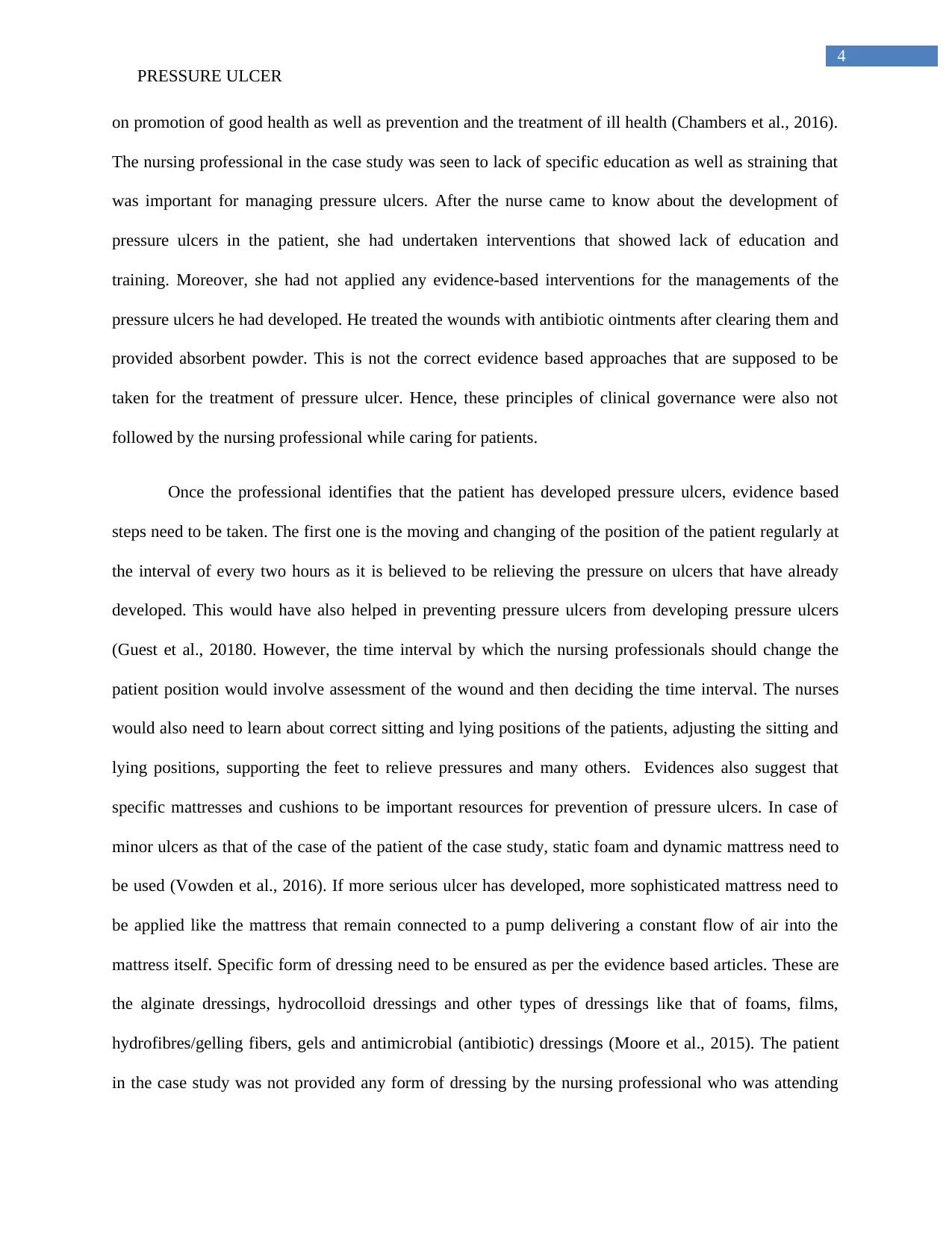
4
PRESSURE ULCER
on promotion of good health as well as prevention and the treatment of ill health (Chambers et al., 2016).
The nursing professional in the case study was seen to lack of specific education as well as straining that
was important for managing pressure ulcers. After the nurse came to know about the development of
pressure ulcers in the patient, she had undertaken interventions that showed lack of education and
training. Moreover, she had not applied any evidence-based interventions for the managements of the
pressure ulcers he had developed. He treated the wounds with antibiotic ointments after clearing them and
provided absorbent powder. This is not the correct evidence based approaches that are supposed to be
taken for the treatment of pressure ulcer. Hence, these principles of clinical governance were also not
followed by the nursing professional while caring for patients.
Once the professional identifies that the patient has developed pressure ulcers, evidence based
steps need to be taken. The first one is the moving and changing of the position of the patient regularly at
the interval of every two hours as it is believed to be relieving the pressure on ulcers that have already
developed. This would have also helped in preventing pressure ulcers from developing pressure ulcers
(Guest et al., 20180. However, the time interval by which the nursing professionals should change the
patient position would involve assessment of the wound and then deciding the time interval. The nurses
would also need to learn about correct sitting and lying positions of the patients, adjusting the sitting and
lying positions, supporting the feet to relieve pressures and many others. Evidences also suggest that
specific mattresses and cushions to be important resources for prevention of pressure ulcers. In case of
minor ulcers as that of the case of the patient of the case study, static foam and dynamic mattress need to
be used (Vowden et al., 2016). If more serious ulcer has developed, more sophisticated mattress need to
be applied like the mattress that remain connected to a pump delivering a constant flow of air into the
mattress itself. Specific form of dressing need to be ensured as per the evidence based articles. These are
the alginate dressings, hydrocolloid dressings and other types of dressings like that of foams, films,
hydrofibres/gelling fibers, gels and antimicrobial (antibiotic) dressings (Moore et al., 2015). The patient
in the case study was not provided any form of dressing by the nursing professional who was attending
PRESSURE ULCER
on promotion of good health as well as prevention and the treatment of ill health (Chambers et al., 2016).
The nursing professional in the case study was seen to lack of specific education as well as straining that
was important for managing pressure ulcers. After the nurse came to know about the development of
pressure ulcers in the patient, she had undertaken interventions that showed lack of education and
training. Moreover, she had not applied any evidence-based interventions for the managements of the
pressure ulcers he had developed. He treated the wounds with antibiotic ointments after clearing them and
provided absorbent powder. This is not the correct evidence based approaches that are supposed to be
taken for the treatment of pressure ulcer. Hence, these principles of clinical governance were also not
followed by the nursing professional while caring for patients.
Once the professional identifies that the patient has developed pressure ulcers, evidence based
steps need to be taken. The first one is the moving and changing of the position of the patient regularly at
the interval of every two hours as it is believed to be relieving the pressure on ulcers that have already
developed. This would have also helped in preventing pressure ulcers from developing pressure ulcers
(Guest et al., 20180. However, the time interval by which the nursing professionals should change the
patient position would involve assessment of the wound and then deciding the time interval. The nurses
would also need to learn about correct sitting and lying positions of the patients, adjusting the sitting and
lying positions, supporting the feet to relieve pressures and many others. Evidences also suggest that
specific mattresses and cushions to be important resources for prevention of pressure ulcers. In case of
minor ulcers as that of the case of the patient of the case study, static foam and dynamic mattress need to
be used (Vowden et al., 2016). If more serious ulcer has developed, more sophisticated mattress need to
be applied like the mattress that remain connected to a pump delivering a constant flow of air into the
mattress itself. Specific form of dressing need to be ensured as per the evidence based articles. These are
the alginate dressings, hydrocolloid dressings and other types of dressings like that of foams, films,
hydrofibres/gelling fibers, gels and antimicrobial (antibiotic) dressings (Moore et al., 2015). The patient
in the case study was not provided any form of dressing by the nursing professional who was attending
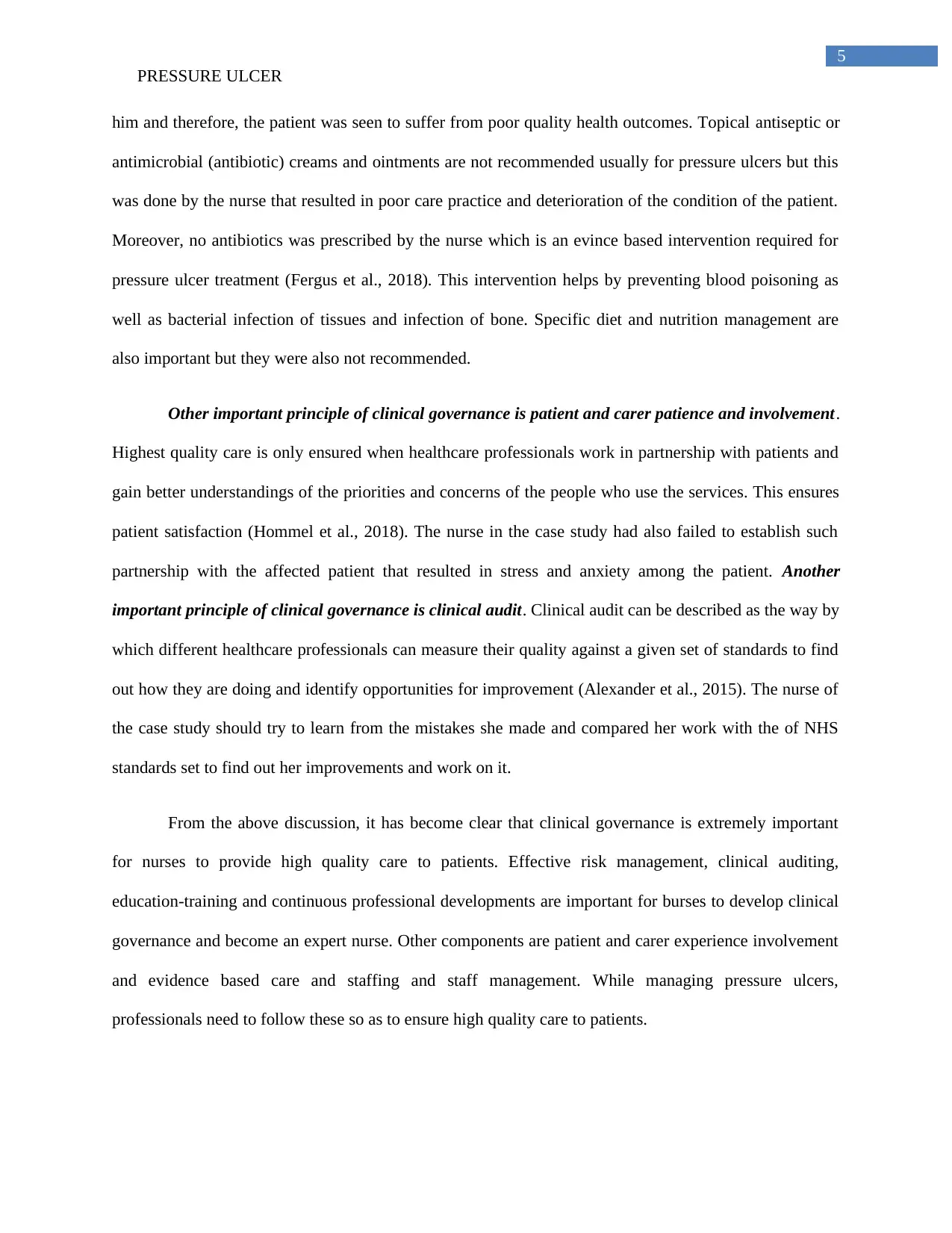
5
PRESSURE ULCER
him and therefore, the patient was seen to suffer from poor quality health outcomes. Topical antiseptic or
antimicrobial (antibiotic) creams and ointments are not recommended usually for pressure ulcers but this
was done by the nurse that resulted in poor care practice and deterioration of the condition of the patient.
Moreover, no antibiotics was prescribed by the nurse which is an evince based intervention required for
pressure ulcer treatment (Fergus et al., 2018). This intervention helps by preventing blood poisoning as
well as bacterial infection of tissues and infection of bone. Specific diet and nutrition management are
also important but they were also not recommended.
Other important principle of clinical governance is patient and carer patience and involvement.
Highest quality care is only ensured when healthcare professionals work in partnership with patients and
gain better understandings of the priorities and concerns of the people who use the services. This ensures
patient satisfaction (Hommel et al., 2018). The nurse in the case study had also failed to establish such
partnership with the affected patient that resulted in stress and anxiety among the patient. Another
important principle of clinical governance is clinical audit. Clinical audit can be described as the way by
which different healthcare professionals can measure their quality against a given set of standards to find
out how they are doing and identify opportunities for improvement (Alexander et al., 2015). The nurse of
the case study should try to learn from the mistakes she made and compared her work with the of NHS
standards set to find out her improvements and work on it.
From the above discussion, it has become clear that clinical governance is extremely important
for nurses to provide high quality care to patients. Effective risk management, clinical auditing,
education-training and continuous professional developments are important for burses to develop clinical
governance and become an expert nurse. Other components are patient and carer experience involvement
and evidence based care and staffing and staff management. While managing pressure ulcers,
professionals need to follow these so as to ensure high quality care to patients.
PRESSURE ULCER
him and therefore, the patient was seen to suffer from poor quality health outcomes. Topical antiseptic or
antimicrobial (antibiotic) creams and ointments are not recommended usually for pressure ulcers but this
was done by the nurse that resulted in poor care practice and deterioration of the condition of the patient.
Moreover, no antibiotics was prescribed by the nurse which is an evince based intervention required for
pressure ulcer treatment (Fergus et al., 2018). This intervention helps by preventing blood poisoning as
well as bacterial infection of tissues and infection of bone. Specific diet and nutrition management are
also important but they were also not recommended.
Other important principle of clinical governance is patient and carer patience and involvement.
Highest quality care is only ensured when healthcare professionals work in partnership with patients and
gain better understandings of the priorities and concerns of the people who use the services. This ensures
patient satisfaction (Hommel et al., 2018). The nurse in the case study had also failed to establish such
partnership with the affected patient that resulted in stress and anxiety among the patient. Another
important principle of clinical governance is clinical audit. Clinical audit can be described as the way by
which different healthcare professionals can measure their quality against a given set of standards to find
out how they are doing and identify opportunities for improvement (Alexander et al., 2015). The nurse of
the case study should try to learn from the mistakes she made and compared her work with the of NHS
standards set to find out her improvements and work on it.
From the above discussion, it has become clear that clinical governance is extremely important
for nurses to provide high quality care to patients. Effective risk management, clinical auditing,
education-training and continuous professional developments are important for burses to develop clinical
governance and become an expert nurse. Other components are patient and carer experience involvement
and evidence based care and staffing and staff management. While managing pressure ulcers,
professionals need to follow these so as to ensure high quality care to patients.
⊘ This is a preview!⊘
Do you want full access?
Subscribe today to unlock all pages.

Trusted by 1+ million students worldwide
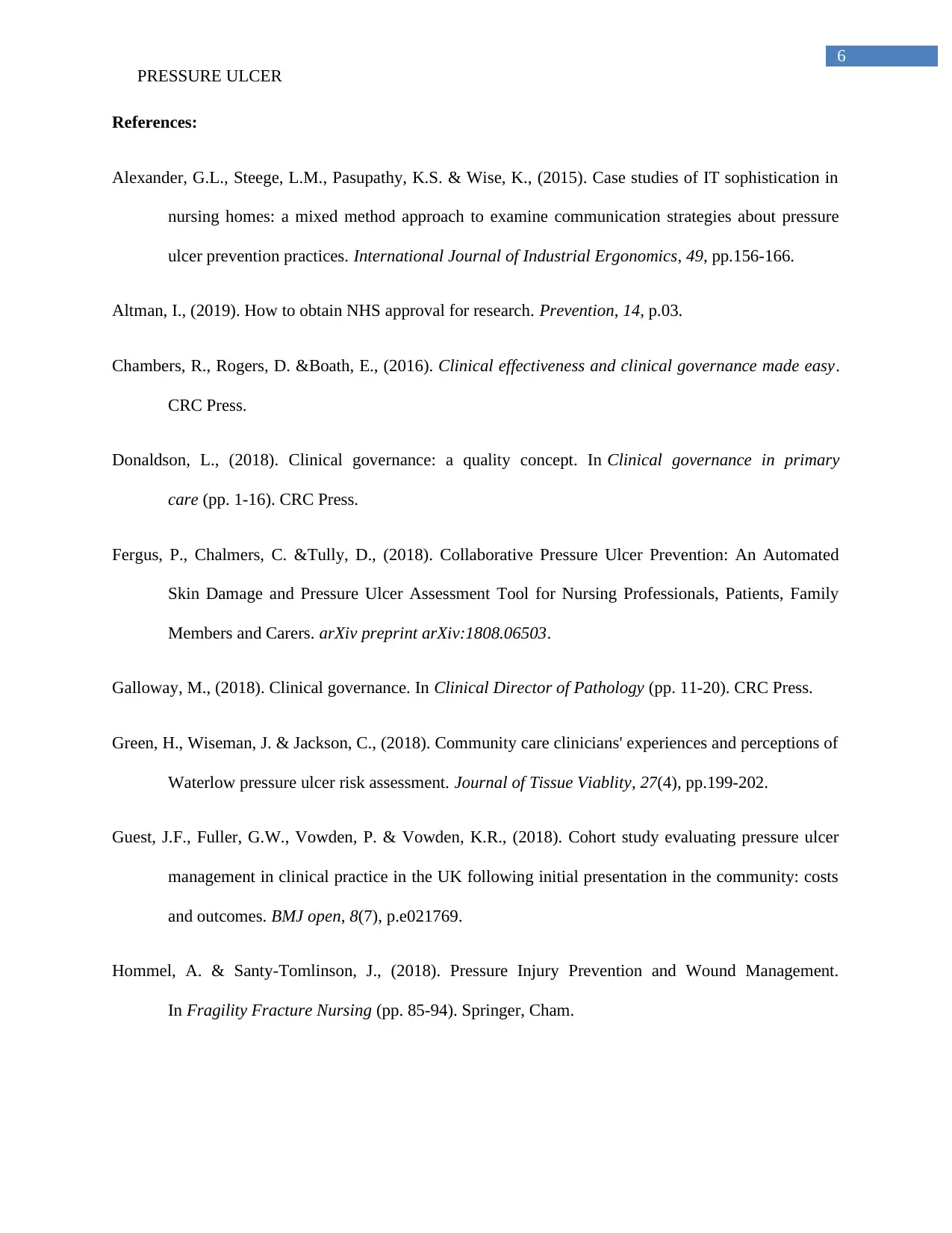
6
PRESSURE ULCER
References:
Alexander, G.L., Steege, L.M., Pasupathy, K.S. & Wise, K., (2015). Case studies of IT sophistication in
nursing homes: a mixed method approach to examine communication strategies about pressure
ulcer prevention practices. International Journal of Industrial Ergonomics, 49, pp.156-166.
Altman, I., (2019). How to obtain NHS approval for research. Prevention, 14, p.03.
Chambers, R., Rogers, D. &Boath, E., (2016). Clinical effectiveness and clinical governance made easy.
CRC Press.
Donaldson, L., (2018). Clinical governance: a quality concept. In Clinical governance in primary
care (pp. 1-16). CRC Press.
Fergus, P., Chalmers, C. &Tully, D., (2018). Collaborative Pressure Ulcer Prevention: An Automated
Skin Damage and Pressure Ulcer Assessment Tool for Nursing Professionals, Patients, Family
Members and Carers. arXiv preprint arXiv:1808.06503.
Galloway, M., (2018). Clinical governance. In Clinical Director of Pathology (pp. 11-20). CRC Press.
Green, H., Wiseman, J. & Jackson, C., (2018). Community care clinicians' experiences and perceptions of
Waterlow pressure ulcer risk assessment. Journal of Tissue Viablity, 27(4), pp.199-202.
Guest, J.F., Fuller, G.W., Vowden, P. & Vowden, K.R., (2018). Cohort study evaluating pressure ulcer
management in clinical practice in the UK following initial presentation in the community: costs
and outcomes. BMJ open, 8(7), p.e021769.
Hommel, A. & Santy-Tomlinson, J., (2018). Pressure Injury Prevention and Wound Management.
In Fragility Fracture Nursing (pp. 85-94). Springer, Cham.
PRESSURE ULCER
References:
Alexander, G.L., Steege, L.M., Pasupathy, K.S. & Wise, K., (2015). Case studies of IT sophistication in
nursing homes: a mixed method approach to examine communication strategies about pressure
ulcer prevention practices. International Journal of Industrial Ergonomics, 49, pp.156-166.
Altman, I., (2019). How to obtain NHS approval for research. Prevention, 14, p.03.
Chambers, R., Rogers, D. &Boath, E., (2016). Clinical effectiveness and clinical governance made easy.
CRC Press.
Donaldson, L., (2018). Clinical governance: a quality concept. In Clinical governance in primary
care (pp. 1-16). CRC Press.
Fergus, P., Chalmers, C. &Tully, D., (2018). Collaborative Pressure Ulcer Prevention: An Automated
Skin Damage and Pressure Ulcer Assessment Tool for Nursing Professionals, Patients, Family
Members and Carers. arXiv preprint arXiv:1808.06503.
Galloway, M., (2018). Clinical governance. In Clinical Director of Pathology (pp. 11-20). CRC Press.
Green, H., Wiseman, J. & Jackson, C., (2018). Community care clinicians' experiences and perceptions of
Waterlow pressure ulcer risk assessment. Journal of Tissue Viablity, 27(4), pp.199-202.
Guest, J.F., Fuller, G.W., Vowden, P. & Vowden, K.R., (2018). Cohort study evaluating pressure ulcer
management in clinical practice in the UK following initial presentation in the community: costs
and outcomes. BMJ open, 8(7), p.e021769.
Hommel, A. & Santy-Tomlinson, J., (2018). Pressure Injury Prevention and Wound Management.
In Fragility Fracture Nursing (pp. 85-94). Springer, Cham.
Paraphrase This Document
Need a fresh take? Get an instant paraphrase of this document with our AI Paraphraser
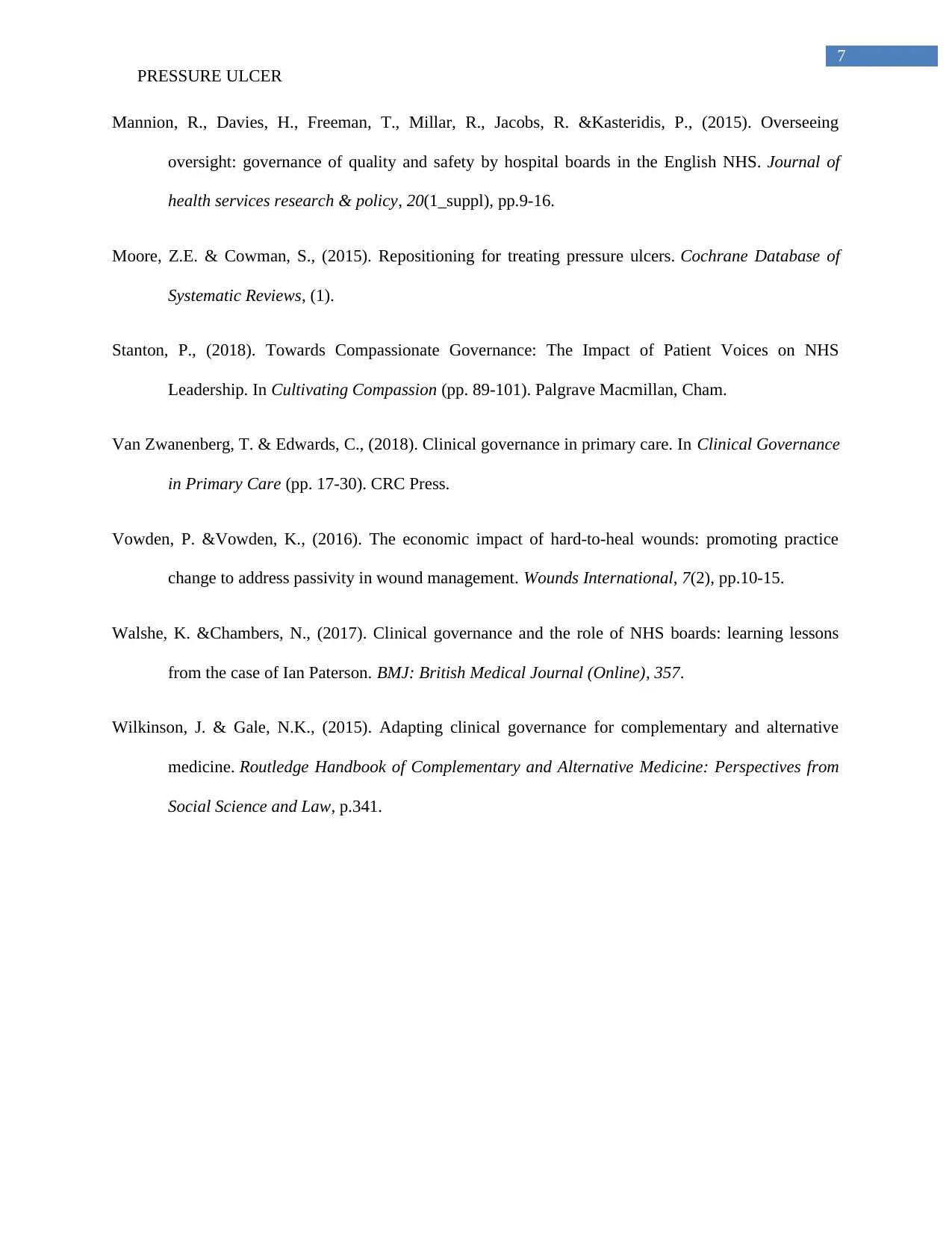
7
PRESSURE ULCER
Mannion, R., Davies, H., Freeman, T., Millar, R., Jacobs, R. &Kasteridis, P., (2015). Overseeing
oversight: governance of quality and safety by hospital boards in the English NHS. Journal of
health services research & policy, 20(1_suppl), pp.9-16.
Moore, Z.E. & Cowman, S., (2015). Repositioning for treating pressure ulcers. Cochrane Database of
Systematic Reviews, (1).
Stanton, P., (2018). Towards Compassionate Governance: The Impact of Patient Voices on NHS
Leadership. In Cultivating Compassion (pp. 89-101). Palgrave Macmillan, Cham.
Van Zwanenberg, T. & Edwards, C., (2018). Clinical governance in primary care. In Clinical Governance
in Primary Care (pp. 17-30). CRC Press.
Vowden, P. &Vowden, K., (2016). The economic impact of hard-to-heal wounds: promoting practice
change to address passivity in wound management. Wounds International, 7(2), pp.10-15.
Walshe, K. &Chambers, N., (2017). Clinical governance and the role of NHS boards: learning lessons
from the case of Ian Paterson. BMJ: British Medical Journal (Online), 357.
Wilkinson, J. & Gale, N.K., (2015). Adapting clinical governance for complementary and alternative
medicine. Routledge Handbook of Complementary and Alternative Medicine: Perspectives from
Social Science and Law, p.341.
PRESSURE ULCER
Mannion, R., Davies, H., Freeman, T., Millar, R., Jacobs, R. &Kasteridis, P., (2015). Overseeing
oversight: governance of quality and safety by hospital boards in the English NHS. Journal of
health services research & policy, 20(1_suppl), pp.9-16.
Moore, Z.E. & Cowman, S., (2015). Repositioning for treating pressure ulcers. Cochrane Database of
Systematic Reviews, (1).
Stanton, P., (2018). Towards Compassionate Governance: The Impact of Patient Voices on NHS
Leadership. In Cultivating Compassion (pp. 89-101). Palgrave Macmillan, Cham.
Van Zwanenberg, T. & Edwards, C., (2018). Clinical governance in primary care. In Clinical Governance
in Primary Care (pp. 17-30). CRC Press.
Vowden, P. &Vowden, K., (2016). The economic impact of hard-to-heal wounds: promoting practice
change to address passivity in wound management. Wounds International, 7(2), pp.10-15.
Walshe, K. &Chambers, N., (2017). Clinical governance and the role of NHS boards: learning lessons
from the case of Ian Paterson. BMJ: British Medical Journal (Online), 357.
Wilkinson, J. & Gale, N.K., (2015). Adapting clinical governance for complementary and alternative
medicine. Routledge Handbook of Complementary and Alternative Medicine: Perspectives from
Social Science and Law, p.341.
1 out of 8
Related Documents
Your All-in-One AI-Powered Toolkit for Academic Success.
+13062052269
info@desklib.com
Available 24*7 on WhatsApp / Email
![[object Object]](/_next/static/media/star-bottom.7253800d.svg)
Unlock your academic potential
Copyright © 2020–2025 A2Z Services. All Rights Reserved. Developed and managed by ZUCOL.





